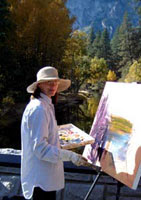
Lately I've been trying to explain to myself why it is that reflections on water are so captivating. This lead me down the path of analyzing the crap out of my own paintings, which is always a little bit dangerous. Intense scrutiny of my own work has historically led to something getting sanded down and painted over. I've since learned that sanding a painting is extremely dangerous due to the heavy metals in the pigments All you artists out there, beware of sanding anything with cadmium in it.
Scrutinizing my work has lately proved more useful and less potentially carcinogenic. Staring at my compositions, I realized that many reflections are basically double images. One side of the double is created by an environment of air and the other by water. The air image is usually lighter, more clear, and shapes are more reasonable, compact. The water images tend to be inky with higher contrast. Shapes are distorted, sometimes growing a little wild. Oooh, a chance for some crazy fun brushwork! Water gives me permission to go a bit more wild with color, contrast and shape. Claude Monet once said that you could find every color imaginable in a reflection.
In many ways reflections are also like dreaming. A body of water is also a reflection of another world. This one is familiar, but it has a few alterations of hue and geometry that give a sense of distortion. Similarly, experiences in the day are often amplified or altered in our dreams.
I've always felt that dreams were important. At times in my life, mine have proven to be extremely prescient. Sometimes it's as though I could sense a life tsunami approaching through my dream imagery. I sometimes work out things I can't figure out when I'm awake. I've even met people in my dreams before we actually met in "awaketime".
Some of these assertions may sound nuts, but at least I'm not alone in my nuttiness. Many cultures have based a huge part of their art around a dream world or space. The Aboriginal tribes of Australia believe that what you do when you are asleep is as important as in your wakeful state, so the "dreamtime" art is a way of describing what happens in that important eyes-closed state. The Egyptians had an entire body of art that described what happened in the land beyond sleep, the eternal sleep as it were.
Speaking of sleep...I could really use some! Sweet dreams, everyone.

